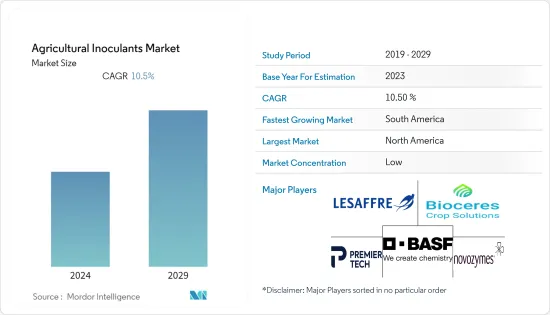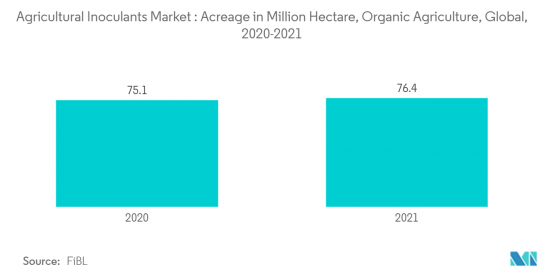 |
市場調査レポート
商品コード
1403976
農業用接種剤:市場シェア分析、産業動向と統計、2024~2029年の成長予測Agricultural Inoculants - Market Share Analysis, Industry Trends & Statistics, Growth Forecasts 2024 - 2029 |
||||||
● お客様のご希望に応じて、既存データの加工や未掲載情報(例:国別セグメント)の追加などの対応が可能です。 詳細はお問い合わせください。
| 農業用接種剤:市場シェア分析、産業動向と統計、2024~2029年の成長予測 |
|
出版日: 2024年01月04日
発行: Mordor Intelligence
ページ情報: 英文 120 Pages
納期: 2~3営業日
|
- 全表示
- 概要
- 目次
農業用接種剤の市場規模は2024年に101億5,000万米ドルと推定され、2029年には167億6,000万米ドルに達すると予測され、予測期間中のCAGRは10.5%で成長します。

主なハイライト
- 現在の農法は、肥料、殺虫剤、除草剤などの化学投入物に大きく依存しており、農産物の栄養価や農業従事者・消費者の健康に悪影響を及ぼしています。これらの化学物質の過剰かつ無差別な使用は、食品汚染、雑草や病気への耐性、環境への悪影響をもたらし、人間の健康に大きな影響を与えています。こうした化学物質の投入は、土壌への有毒化合物の蓄積を促進します。
- 合成肥料の中には、塩酸ラジカルや硫酸ラジカルなどの酸性ラジカルを含むものがあり、土壌の酸性度を高め、土壌や植物の健康に悪影響を及ぼします。また、難分解性の高い化合物は、植物によっては吸収されることもあります。そのような作物を継続的に摂取すると、人間の体系的な障害につながる可能性があります。
- そのため、質の悪い作物の消費による健康課題に対する意識の高まりから、人間の健康を損なうことなく農産物の量と質を向上させるための、新たな改良技術が求められています。
- 化学物質投入に代わる確実な方法として、バイオ肥料、バイオ除草剤、バイオ農薬、バイオ防除剤として機能する微生物接種剤があります。それらは、生産性と作物の健康を改善するために土壌や植物に施用される受益微生物です。また、害虫を駆除し、地面や作物の品質を向上させるためにも広く利用されています。
- さらに、有機農業の採用を促進するための政府のイニシアチブは、調査期間中に市場の成長を促進すると予想されています。例えば、グリーンディールのFarm to Fork戦略の下、欧州委員会は、2030年までにEUの農地の少なくとも25%を有機農業の下に置き、有機養殖を大幅に増加させるという目標を設定しました。
農業用接種剤の市場動向
有機農法と環境に優しい農法の採用
- 農法は慣行農法から有機農法へと移行する傾向にあります。このシフトは、従来の農法が人間の健康や環境の安全に与える悪影響に対する意識の高まりに起因しています。
- 有機農業調査研究所(ドイツ語:Forschungsinstitut fur biologischen Landbau(FiBL))によると、有機栽培面積は2018年の7,090万haから2021年には7,640万haに増加し、187カ国が有機農業を実践しています。このため、接種剤のような有機ソリューションへの需要が高まり、官民による地域密着型の研究への投資が増加しています。
- 微生物接種剤は、土壌の健全性を向上させ、栄養の利用可能性を高め、病気から保護することができるため、合成投入物に代わる自然で持続可能な選択肢を提供します。さらに、微生物接種剤は、合成投入物の環境への影響を軽減し、より持続可能な農法を促進するのに役立ちます。
- その結果、微生物接種剤の需要は、環境フットプリントを削減し、より健康的で持続可能な作物を生産する方法を探している農家の間で増加しています。さらに、農地面積の増加と有機製品に対する消費者の需要の増加は、予測期間中、農業用接種剤市場にプラスの影響を与えると思われます。

北米が最大市場
- 北米は農業用接種剤の最大市場であり、米国がシェアの大半を占めています。高度に発展した農業部門を持つ米国は、最近、自然農法や有機農法を採用しています。化学物質の投入コストの増加、土壌量や環境への悪影響、バランスのとれた植物栄養に関する意識の高まりが、同国の市場を牽引する主な要因となっています。
- さらに、特定の企業や研究機関は、競争上の優位性を得るために新製品の導入を重視しています。例えば、ウィニペグのバイオ研究企業XiteBio Technologiesが開発したXiteBio OptiPlusは、市場で実績のあるAGPT(Advanced Growth Promoting Technology)を利用した、画期的な大豆用液体接種剤です。
- これは、窒素固定細菌Bradyrhizobium japonicumと、2021年2月にカナダで登録された特許取得済みのリン酸可溶化植物成長促進根粒菌(PGPR)を組み合わせたもので、大豆専用に設計されています。このような新興国市場の開拓は、この地域における農業用接種剤の需要を創出し、調査期間中の世界市場に影響を与えると予想されます。
農業用接種剤産業の概要
農業用接種剤市場は断片化されており、国際的なプレーヤーが主要な市場シェアを占めています。主要企業は、研究開発活動、広範な製品ポートフォリオ、地理的拡大、買収、積極的なプロモーション戦略に注力し、市場での地位を維持しています。大手企業には、Novozymes、Lesaffre、BioceresCrop Solutions、Premier Tech、BASF SEなどがあります。
その他の特典
- エクセル形式の市場予測(ME)シート
- 3ヶ月間のアナリストサポート
目次
第1章 イントロダクション
- 調査の前提条件と市場定義
- 調査範囲
第2章 調査手法
第3章 エグゼクティブサマリー
第4章 市場力学
- 市場概要
- 市場促進要因
- 有機農法と環境に優しい農法の採用
- 耕地面積の減少と食糧安全保障への懸念の高まり
- 市場抑制要因
- 従来型製品や合成製品に対する高い需要
- 農業用接種剤の採用を制限する認識不足とその他の要因
- ポーターのファイブフォース分析
- 供給企業の交渉力
- 買い手/消費者の交渉力
- 新規参入業者の脅威
- 代替品の脅威
- 競争企業間の敵対関係の強さ
第5章 市場セグメンテーション
- 機能
- 作物栄養
- 作物保護
- 微生物
- バクテリア
- 根粒菌
- アゾトバクター
- ホスホバクテリア
- その他の細菌
- 菌類
- トリコデルマ
- 菌根菌
- その他の菌類
- その他の微生物
- バクテリア
- 施用方法
- 種子接種
- 土壌接種
- 作物タイプ
- 穀物
- 豆類および油糧種子
- 商業作物
- 果物および野菜
- その他の用途
- 地域
- 北米
- 米国
- カナダ
- メキシコ
- その他北米地域
- 欧州
- ドイツ
- 英国
- フランス
- スペイン
- ロシア
- イタリア
- その他欧州
- アジア太平洋
- 中国
- 日本
- インド
- オーストラリア
- その他アジア太平洋地域
- 南米
- ブラジル
- アルゼンチン
- その他南米
- アフリカ
- 南アフリカ
- その他のアフリカ
- 北米
第6章 競合情勢
- 最も採用されている戦略
- 市場シェア分析
- 企業プロファイル
- BASF SE
- Premier Tech
- Lallemond Inc.
- Novozymes
- Mapleton Agri Biotec Pty Ltd
- New Edge Microbials Pty Ltd
- T.Stanes & Company Limited
- AEA Investors(Verdesian Life Sciences LLC)
- Lesaffre
- Bioceres Crop Solutions
第7章 市場機会と今後の動向

The agricultural inoculants market size is estimated at USD 10.15 billion in 2024 and is expected to reach USD 16.76 billion by 2029, growing at a CAGR of 10.5% during the forecast period.
Key Highlights
- Current agricultural practices depend heavily on chemical inputs, such as fertilizers, pesticides, and herbicides, which cause a deleterious effect on the nutritional value of farm products and the health of farm workers and consumers. Excessive and indiscriminate use of these chemicals has resulted in food contamination, weed and disease resistance, and adverse environmental outcomes, significantly impacting human health. Applying these chemical inputs promotes the accumulation of toxic compounds in soils.
- Several synthetic fertilizers contain acid radicals, such as hydrochloride and sulfuric radicals, increasing soil acidity and adversely affecting soil and plant health. Highly recalcitrant compounds can also be absorbed by some plants. Continuous consumption of such crops can lead to systematic disorders in humans.
- Therefore, the increasing awareness of health challenges due to the consumption of poor-quality crops has led to a quest for new and improved technologies to improve the quantity and quality of produce without jeopardizing human health.
- A reliable alternative to chemical inputs is microbial inoculants that can act as biofertilizers, bioherbicides, biopesticides, and biocontrol agents. They are beneficiary microorganisms applied to the soil or the plant to improve productivity and crop health. They are also widely used to control pests and improve the quality of the ground and crops.
- Moreover, government initiatives to promote the adoption of organic farming are anticipated to fuel the market growth during the study period. For instance, under the Green Deal's Farm to Fork strategy, the European Commission set a target of at least 25% of the EU's agricultural land under organic farming and a significant increase in organic aquaculture by 2030.
Agricultural Inoculants Market Trends
Adoption of Organic and Eco-friendly Farming Practices
- Agricultural practices are witnessing a trend shift from conventional to organic farming. This shift can be attributed to growing awareness about the adverse impact of traditional farming methods on human health and environmental safety.
- According to the Research Institute of Organic Agriculture (German: Forschungsinstitut fur biologischen Landbau (FiBL)), the area under organic cultivation increased from 70.9 million ha in 2018 to 76.4 million ha in 2021, with 187 countries practicing organic agriculture. This increases the demand for organic solutions such as inoculants and investments in localized research by private and public sectors.
- Microbial inoculants offer a natural and sustainable alternative to synthetic inputs, as they can improve soil health, increase nutrient availability, and protect against diseases. Additionally, microbial inoculants help reduce the environmental impact of synthetic inputs and promote more sustainable farming practices.
- As a result, the demand for microbial inoculants is increasing among farmers looking for ways to reduce their environmental footprint and produce healthier, more sustainable crops. Moreover, rising acreage and growing consumer demand for organic products will positively influence the agricultural inoculants market during the forecast period.

North America is the Largest Market
- North America is the largest market for agricultural inoculants, with the United States holding the majority of the share. The United States, with its highly evolved agricultural sector, has been adopting the natural and organic way of farming lately. The increasing cost of chemical inputs, their adverse effect on soil mass and the environment, and increasing awareness regarding balanced plant nutrition are the major factors driving the market in the country.
- Moreover, certain companies and research institutions emphasize introducing new products to gain a competitive advantage. For instance, developed by the Winnipeg bioresearch company XiteBio Technologies, XiteBio OptiPlus is a revolutionary proprietary liquid inoculant for soybeans powered by market-proven AGPT (Advanced Growth Promoting Technology).
- It combines the nitrogen-fixing bacteria Bradyrhizobium japonicum with patented phosphate-solubilizing plant growth-promoting rhizobacteria (PGPR), registered in Canada in February 2021, designed explicitly for soybeans. Such developments are anticipated to create demand for agricultural inoculants in the region and influence the global market during the study period.
Agricultural Inoculants Industry Overview
The agricultural inoculants market is fragmented, with international players occupying a major market share. The major players focus on R&D activities, extensive product portfolios, geographical expansions, acquisitions, and aggressive promotional strategies to uphold their position in the market. Some of the leading players are Novozymes, Lesaffre, BioceresCrop Solutions, Premier Tech, and BASF SE.
Additional Benefits:
- The market estimate (ME) sheet in Excel format
- 3 months of analyst support
TABLE OF CONTENTS
1 INTRODUCTION
- 1.1 Study Assumptions and Market Definition
- 1.2 Scope of the Study
2 RESEARCH METHODOLOGY
3 EXECUTIVE SUMMARY
4 MARKET DYNAMICS
- 4.1 Market Overview
- 4.2 Market Drivers
- 4.2.1 Adoption of Organic and Eco-friendly Farming Practices
- 4.2.2 Declining Area of Arable Land and Rising Food Security Concerns
- 4.3 Market Restraints
- 4.3.1 High Demand for Conventional and Synthetic Products
- 4.3.2 Lack of Awareness and Other Factors Limiting the Adoption of Agricultural Inoculants
- 4.4 Porter's Five Forces Analysis
- 4.4.1 Bargaining Power of Suppliers
- 4.4.2 Bargaining Power of Buyers/Consumers
- 4.4.3 Threat of New Entrants
- 4.4.4 Threat of Substitute Products
- 4.4.5 Intensity of Competitive Rivalry
5 MARKET SEGMENTATION
- 5.1 Function
- 5.1.1 Crop Nutrition
- 5.1.2 Crop Protection
- 5.2 Microorganism
- 5.2.1 Bacteria
- 5.2.1.1 Rhizobacteria
- 5.2.1.2 Azotobacter
- 5.2.1.3 Phosphobacteria
- 5.2.1.4 Other Bacteria
- 5.2.2 Fungi
- 5.2.2.1 Trichoderma
- 5.2.2.2 Mycorrhiza
- 5.2.2.3 Other Fungi
- 5.2.3 Other Microorganisms
- 5.2.1 Bacteria
- 5.3 Mode of Application
- 5.3.1 Seed Inoculation
- 5.3.2 Soil Inoculation
- 5.4 Crop Type
- 5.4.1 Grains and Cereals
- 5.4.2 Pulses and Oilseeds
- 5.4.3 Commercial Crops
- 5.4.4 Fruits and Vegetables
- 5.4.5 Other Applications
- 5.5 Geography
- 5.5.1 North America
- 5.5.1.1 United States
- 5.5.1.2 Canada
- 5.5.1.3 Mexico
- 5.5.1.4 Rest of North America
- 5.5.2 Europe
- 5.5.2.1 Germany
- 5.5.2.2 United Kingdom
- 5.5.2.3 France
- 5.5.2.4 Spain
- 5.5.2.5 Russia
- 5.5.2.6 Italy
- 5.5.2.7 Rest of Europe
- 5.5.3 Asia-Pacific
- 5.5.3.1 China
- 5.5.3.2 Japan
- 5.5.3.3 India
- 5.5.3.4 Australia
- 5.5.3.5 Rest of Asia-Pacific
- 5.5.4 South America
- 5.5.4.1 Brazil
- 5.5.4.2 Argentina
- 5.5.4.3 Rest of South America
- 5.5.5 Africa
- 5.5.5.1 South Africa
- 5.5.5.2 Rest of Africa
- 5.5.1 North America
6 COMPETITIVE LANDSCAPE
- 6.1 Most Adopted Strategies
- 6.2 Market Share Analysis
- 6.3 Company Profiles
- 6.3.1 BASF SE
- 6.3.2 Premier Tech
- 6.3.3 Lallemond Inc.
- 6.3.4 Novozymes
- 6.3.5 Mapleton Agri Biotec Pty Ltd
- 6.3.6 New Edge Microbials Pty Ltd
- 6.3.7 T.Stanes & Company Limited
- 6.3.8 AEA Investors (Verdesian Life Sciences LLC)
- 6.3.9 Lesaffre
- 6.3.10 Bioceres Crop Solutions
